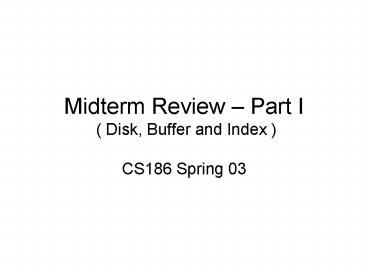Midterm Review - PowerPoint PPT Presentation
Title:
Midterm Review
Description:
Heap file (list / page directory) Record format (fixed length / variable length) ... I/O cost of operation (see next page) Basics about indexes. Why use? Speed ... – PowerPoint PPT presentation
Number of Views:22
Avg rating:3.0/5.0
Title: Midterm Review
1
Midterm Review Part I ( Disk, Buffer and Index
)
- CS186 Spring 03
2
Content
- Quick Review
- Questions from You
- Disk Example
- Buffer Example
- B Tree Example (1)(2)
3
Quick Review
- Disk
- Components of disk
- Disk access time
- seek rotation delay transfer
- Disk space management
- Heap file (list / page directory)
- Record format (fixed length / variable length)
- Page format - fixed / variable (slot directory)
4
Quick Review cont.
- Buffer Management
- Buffer pool
- pin / unpin, dirty, etc.
- Buffer replacement policy(LRU, MRU, Clock)
- How they works?
- Advantage?
- Problem?
- e.g. sequential flooding in LRU
5
Quick Review cont.
- File Storage
- Heap / Sorted / Clustered file
- I/O cost of operation (see next page)
- Basics about indexes
- Why use? Speed up selection on keys.
- Classification
- Clustered vs. Unclustered
- Related to cost!
- How indexes are organized?
- Pros and cons?
6
Quick Review cont.
Empirical study show that pages are about 67
occupancy. ? The number of physical data pages
is about 1.5B
Heap File Sorted File Clustered File
Scan all records BD BD 1.5 BD
Equality Search 0.5 BD (log2B) D (logF1.5B) D
Range Search BD (log2B) match pgD (logF1.5B) match pgD
Insert 2D ((log2B)B)D ((logF1.5B)1) D
Delete 0.5BD D ((log2B)B)D (because R,W 0.5) ((logF1.5B)1) D
Ignore the case when leaf is full, so only one
write here.
2 0.5BD (readwrite) for moving the later parts
of the file
B The number of data pages D (Average) time
to read or write disk page
7
Quick Review cont.
- Tree Structured Index
- ISAM
- How the index is organized?
- Know about how to insert, delete
- B Tree
- Features (pros and cons)
- How the index is organized?
- Familiar with bulk load, insert, delete
- Simple computation using fanout, order, height
8
Questions From You
- For variable-length records page format (lecture
3), do we pack on removal? Doesn't seem like it
would be an easy or cheap operation... But how
else can we reclaim free space? - Do not pack each time. Pack the space only when
not enough free space. - Dense vs. sparse index?
- Not in the coverage of this semester
9
Disk Example
- (Fall 1999 Midterm)Consider a disk with a
sector size of 512 bytes, 100 sectors per track.
Given a rotational speed of 7200 revolutions per
second, what is the maximum rotational delay to
the start of a sector? Assuming that one track of
data can be transferred per revolution, what is
the transfer rate? - Maximum rotational delay1/7200 sec
- Average rotational delay 0.5(1/7200)
- Transfer rate 5121007200 bytes/sec.
10
Buffer Example
- ( Fall 1999 Midterm )Assume that in the
CUSTOMERS table, records are much larger than
shown in the table on the page in fact, each
record fits in exactly one page, so the CUSTOMERS
table is 5 pages long. And also assume that there
is room for only two buffers that is, there are
two buffer frames in memory, and that these
buffers start out empty. - Is LRU or MRU a better strategy if we are reading
the CUSTOMERS records in the order Cid 1, 1,
3, 4, 3, 1, 2. Explain your answer.
11
Buffer Example cont.
- 1, 1, 3, 4, 3, 1, 2
LRU
1 1 1 4 4 1 1
3 3 3 3 2
MRU
1 1 1 1 1 1 2
3 4 3 3 3
12
B Tree Example (1)
- (Fall 2002 Final)For each of the following B
Trees, decide whether it is a valid B Tree
(i.e., one that could exist after numerous
inserts and deletes) or if it is invalid. Circle
your choice, and if it is invalid, describe in
one sentence the single main reason why. - The trees follow all rules in the book including
merging on delete. - All of the trees are of order d2.
13
B Tree Example (1) cont.
Valid
14
B Tree Example (1) cont.
Invalid
15
B Tree Example (1) cont.
Valid
16
B Tree Example (1) cont.
Invalid
17
B Tree Example (1) cont.
Invalid
18
B Tree Example (1) cont.
Invalid
19
B Tree Example (2)
- (Spring 2002 Midterm)Consider a B tree
containing the elements 2, 4, 8, 9, 11, 12, 13,
14, 16, 17, 18, 20. The tree has order d 2.
This means that internal nodes have at least 2
entries and 3 pointers and at most 4 entries and
5 pointers leaf nodes have at least 2 entries
and at most 4 entries.
20
B Tree Example (2) cont.
- bulk-load(2, 4, 8, 9, 11, 12, 13, 14, 16, 17,
18, 20)
21
B Tree Example (2) cont.
- Based on your original tree from above, what is
the minimum number of deletions required to
change the tree into one single leaf node?































